All indoor gardeners will vouch for the fact that there is nothing more satisfying than watching their dear houseplants multiply in front of their eyes. The good news is there are lots of easy houseplants to propagate – you don’t even need to be a ‘pro’ to ‘pro’pagate them!
It is understandable if you feel you lack the experience or knowledge to successfully propagate your houseplants. But don’t let that hesitation stop you from trying.
Whether it is the hardy Snake Plant or delicate and decorative Calatheas or the low maintenance Umbrella Plant – it is a breeze to propagate each of them.
Listed below are 15 easy houseplants to propagate (I’m sure some of them are already adorning a corner of your home) that will help you multiply your plant collection in no time.
Pothos (Epipremnum aureum)
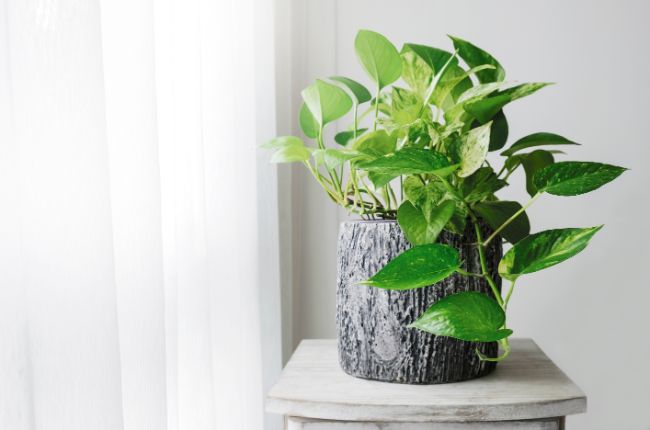
Pothos is one of the most popular houseplants across the world. It is one of the most undemanding ones too as it thrives beautifully even in low light conditions with minimal watering.
This hardiness, coupled with the plant’s attractive foliage that tends to dramatically fall over the sides of the pot, makes it an absolute favorite among new plant parents.
Now propagating a Pothos plant just requires you to identify a healthy stem with at least 4 to 5 leaves on it. You can snip the stem right below the root node and then place it in a jar of water. In about 3-4 weeks, the stem should develop roots of its own.
Once that happens, your propagated Pothos is ready to be shifted to a container with well-draining soil and proper drainage holes. Super simple!
Spider Plant (Chlorophytum comosum)
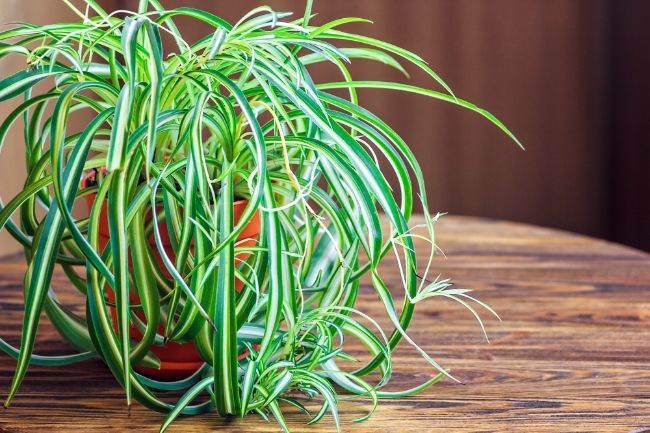
The spider plant looks absolutely gorgeous in a hanging pot with its long and thin white-striped green foliage dangling down the container.
Also referred to as the ‘airplane plant’ or the ‘ribbon plant’, this beauty is a super popular houseplant due to its easy-going nature and its ability to easily adapt to its surroundings.
The best part is that this plant has an interesting growth habit – it produces tiny spider-like plantlets towards the end of its long leaves that make them incredibly easy houseplants to propagate, even for people without a green thumb.
There are two main methods to propagate a Spider Plant – you can either pot the tiny plantlet in a small container without separating it from the main plant and wait until you see signs of new growth that show the baby is ready to be severed from the mother plant.
Alternatively, you can straight away cut the plantlet from the parent and plant it into a small container with regular potting mix. But make sure you choose a plantlet with well-developed root system.
Snake Plant (Dracaena trifasciata)
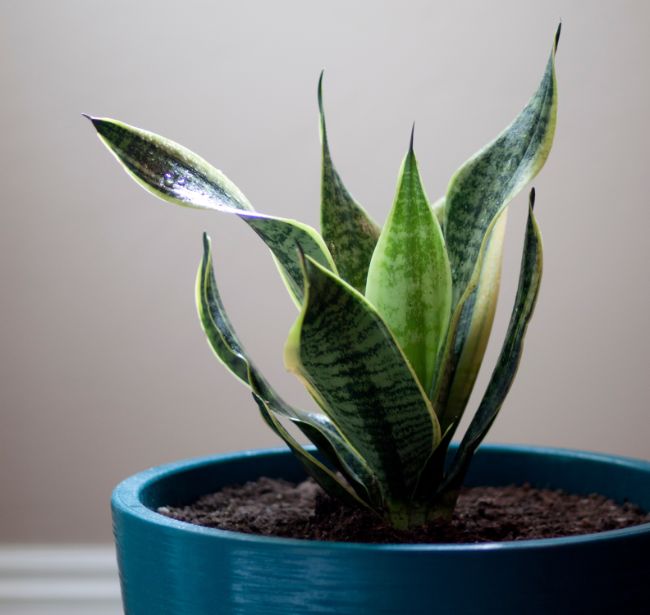
Most plant parents have a special place in their hearts for Snake Plants. This is because they are probably the only houseplants that can tolerate days of neglect and still not complain.
This plant is known by quite a few interesting names like the Mother-in-Law’s Tongue, Snake’s Tongue, or the Devil’s Tongue, thanks to its striking sword-shaped leaves.
Whatever you choose to call it, there is no denying the fact that a Snake Plant is the most non-fussy of all houseplants and thankfully, is pretty easy to propagate too.
These easy houseplants to propagate can be grown from any healthy leaf. Just root it in either soil or water. When rooting in water, take care to only submerge the bottom of the cut leaf. In a matter of days, you’ll notice small roots developing.
However, the easiest way to propagate Snake Plants is by division. In this method, you are required to gently separate a clump of leaves with roots attached to the main plant using a clean and sharp knife or pruners and then repot in its own container.
For more info, read my complete guide to propagating Snake Plants, or my Snake Plant care guide.
Jade Plant (Crassula ovata)
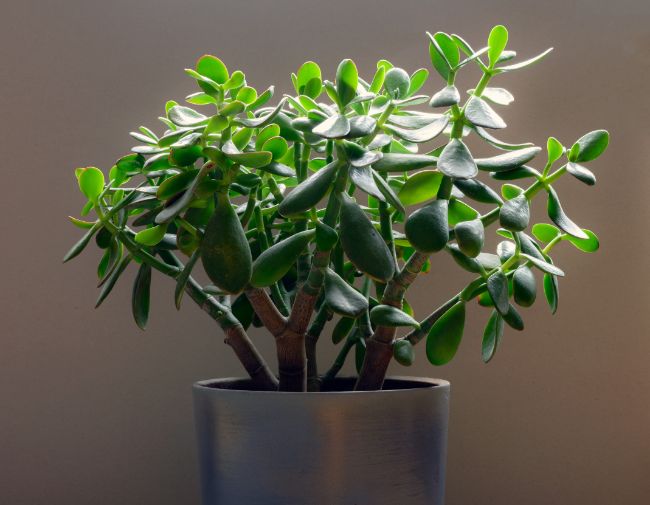
I know people who’ve had Jade Plants for years and they’ve propagated them over and over and shared the baby plants with their dear ones. And these people are not even great gardening enthusiasts!
So you get it, right? Jade Plants are super easy to propagate, even if you’re a novice in the world of indoor gardening.
A Jade Plant is an attractive succulent with tiny, fleshy oval-shaped leaves. It is a low-maintenance plant that should be propagated in warm months for best results, and you can propagate it from both stems as well as leaf cuttings. But if you’re in a hurry, propagation from stem cutting will yield faster results.
In both cases, you need to take the clipping (stem or leaf), dip it in a rooting hormone for higher chances of success, and then plant them in a small, well-draining container with moist (but not soggy) soil. With plenty of humidity and bright indirect light, you can expect the roots to form in about a month. Read my Jade Plant care guide to learn more about propagating and caring for Jade Plants
Heartleaf Philodendron (Philodendron hederaceum)
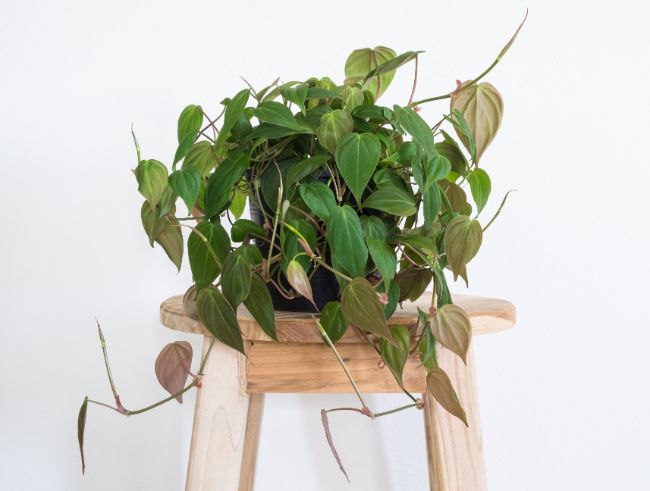
What’s not to love about the elegant Sweetheart Plant or the Heartleaf Philodendron, should you choose to call it that! With its lovely heart-shaped foliage, this plant is a must-have if you’re a sucker for all things romantic and charming.
It is also pretty easy to care for – just give it some light, water, and love, and this plant is bound to flourish.
Also, propagating the Sweetheart Plant is easier than getting your sweetheart on the same page as you when it comes to weekend plans. Much, much easier, in fact!
All you need to propagate it is a pair of scissors, a 3-6 inch stem cutting with leaves on the lower end removed, and a small pot with regular potting mix or a container with water if you want to root the plant in water.
When rooting in water, make sure the leafless end of the stem only sits in the water. In a few weeks, you can expect the roots to form. Check out my Heartleaf Philodendron care guide to learn more.
English Ivy (Hedera helix)
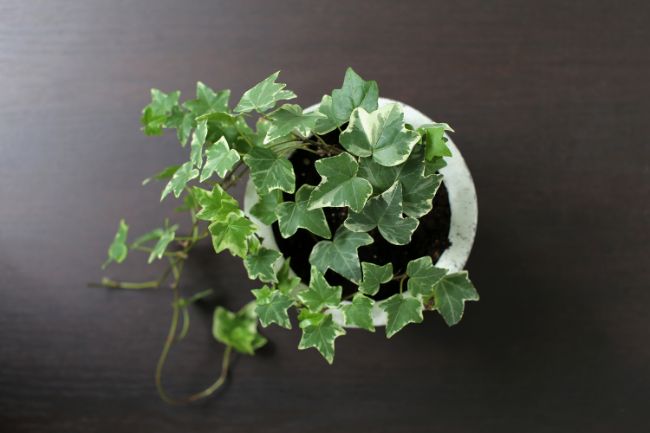
The evergreen vines of English Ivy cover buildings in many parts of the world. This classic plant acts as an attractive ground cover for gardens and does wonderfully well as a decorative houseplant when planted in containers where all its trailing vines can freely hang down.
To propagate English Ivy, you can take a large stem with multiple leaves and cut it into smaller pieces – but make sure to cut directly above a leaf. Now dip the end of the cuttings in a rooting hormone and then root them in a rooting medium (sand-soil mix).
Water the rooting medium and place the pot in a well-lit area inside a plastic bag to create a greenhouse-like surrounding to trap in moisture. In one to two months, you should be seeing new growth on the cuttings.
Alternatively, you can propagate English Ivy cuttings in water. It’s one of my favorite plants to water propagate, and I’ve written an article all about water propagating Ivy.
Nerve Plant (Fittonia albivenis)
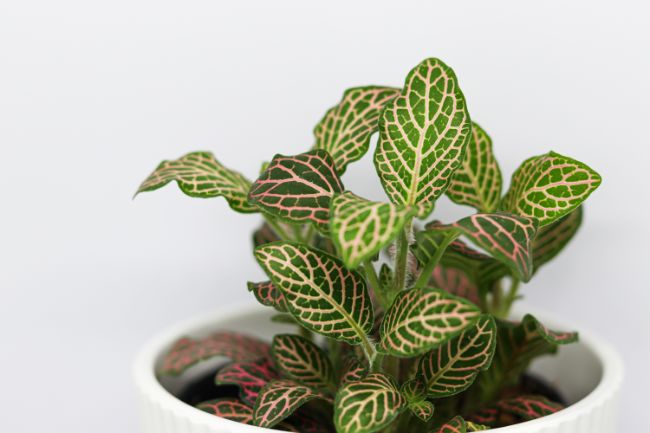
The Nerve Plant, with its lush green foliage exhibiting delicate veins of white, pink or red, is a much sought after houseplant owing to its striking appearance.
Although it is not the most easy-going plant due to its attention-seeking nature (forget to water it on schedule and it is likely to show its displeasure by wilting), propagating it is not difficult at all!
You can propagate a Nerve Plant either by stem or leaf cuttings. It is advisable to propagate it in spring or early summer for better chances of success.
Remember that Nerve Plants absolutely LOVE humidity, so once you plant the stem/leaf cutting in moist potting soil, make sure to put the little container inside a plastic bag to keep humidity levels high and place it in a bright, warm place. You can expect to see the roots developing in 2 to 4 weeks.
Read my guide to Nerve Plant care to learn more about all aspects of growing Nerve Plants.
Chinese Money Plant (Pilea peperomioides)
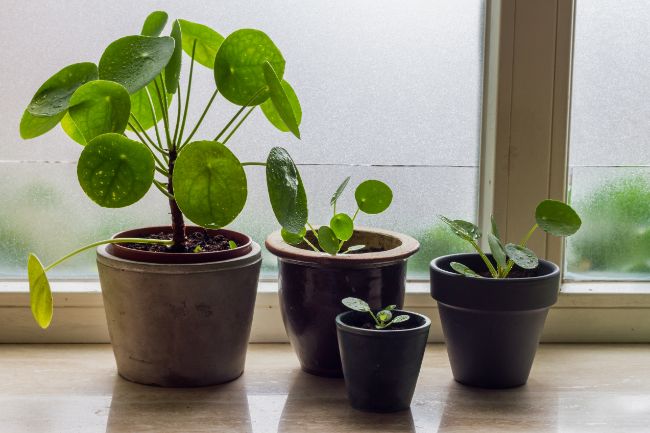
Do you know why the Chinese Money Plant is also referred to as the ‘Friendship Plant’ or the ‘Pass-it-on Plant’? It is because this beauty is so simple to propagate that people have been passing on newly propagated pilea ‘pups’ (yes, pilea plantlets are actually called ‘pups’!) to their friends for decades.
Its tiny round and glossy leaves have also earned it some fun nicknames like the Pancake Plant, UFO Plant or the Saucer Plant.
Pilea Plants, when healthy and mature, sprout tiny plantlets that you can see emerging from the main stem or just popping up from the soil. So propagating this plant just requires carefully separating the pups from the parent plant and then shifting them to their own tiny containers with proper drainage holes and well-draining potting mix.
But make sure that the pups that you remove are big enough to survive on their own.
Another way to propagate the Chinese Money Plant involves removing a thick and healthy stem and then rooting it in water.
Swiss Cheese Plant (Monstera deliciosa)

The Swiss Cheese Plant or the Monstera deliciosa has a distinguished appearance with its broad green leaves, often with holes in them. Since this plant grows on tropical jungle floors (its native habitat), it tends to develop holes in its leaves so that the sun and rain can easily reach its roots.
The Swiss Cheese Plant is an ideal option for beginners in indoor gardening as it does not demand too much attention and care. In fact, the ‘Monstera’ can grow to become ‘monstrous’ under ideal conditions in just a few months. This is when you should consider propagating it from stem cuttings.
For propagating a Monstera, you can take a few stem cuttings, but remember to cut directly below a node. Gently remove any extra leaves (two to three per stem cutting is okay) and then place the cuttings in water, or directly into soil for rooting.
Put the container in a warm, bright location and change the water regularly. Now wait patiently until the cuttings start developing roots of their own.
Arrowhead Plant (Syngonium podophyllum)
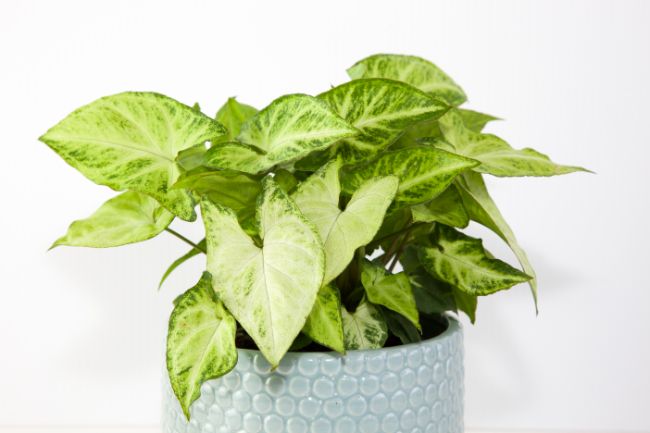
The Arrowhead Plant gets its name from its unique arrowhead-shaped leaves that make it a fantastic green addition to any space. These plants are basically vines and have multiple thick but soft stems with heavy foliage. Therefore, you might need to prune this beauty periodically to prevent the leaves from flopping too much.
Now the best part is you can actually propagate an Arrowhead Plant while pruning it by using the stem cuttings to create little replicas of your dear houseplant. The best time to propagate a Syngonium Plant is late spring and summer.
All you need to do is take stem cuttings with at least 2 to 3 nodes that can be rooted either in water or in soil. It is best to remove any extra leaves towards the bottom of the cuttings. In a matter of 2 to 3 weeks, you should be able to notice the roots developing. Read more about Arrowhead Plant propagation and how to look after these wonderful houseplants.
Calatheas

Calatheas are among the most attractive tropical houseplants that owe their stunning looks to their colorful, patterned foliage. Apparently, this plant knows how appealing it is to plant enthusiasts, and that’s why it doesn’t mind showing some sass when it comes to caring for it. Not too easy to impress, this one!
Thankfully, propagating Calatheas is another matter. You can easily propagate a Calathea by division and the best time to do that is early spring. In fact, Calatheas thrive when divided and repotted every year.
To propagate a Calathea, you should first gently remove the entire plant from the container. Identify a clump of stems with a proper root system that is not too entangled with the mother plant’s roots and carefully remove it using a clean knife.
Now pot it into a new container with proper drainage holes and well-draining soil. Keep the new plant in a location with part shade and high humidity, and it is bound to thrive.
I’ve written a step by step guide to propagating Calathea orbifolia, with some lovely descriptive photos to help. I’ve also written care guides for a number of Calathea species, including Calathea orbifolia, Calathea ornata, Calathea zebrina, and Calathea makoyana.
Umbrella Plant (Schefflera arboricola)

Yet another charming houseplant, Schefflera arboricola is pretty easy to propagate. Due to its oval-shaped variegated leaves growing in the shape of an umbrella, it is known as the Umbrella Plant.
Under ideal conditions, it can grow up to a height of 8 feet and take up quite a bit of room in your indoor space. That is when you can decide to prune it a bit and use the cuttings to grow brand new umbrella plants.
Please note that you can also propagate Umbrella Plants from leaf cuttings. For this method, you should choose healthy leaves with leafstalk attached and place them around 1 cm deep in a tiny container with moist, but well-draining potting mix.
Keep the container in a plastic bag to trap in humidity and put it in a well-lit area. With proper moisture and lighting, rooting will begin in a matter of 2-3 months.
Mother Of Thousands (Bryophyllum daigremontianum)

Now this one has a pretty interesting name – and a highly fitting one too as it is capable of growing scores of plantlets along the edge of each of its leaves that often drop off and grow as separate plants!
If you’re looking for easy houseplants to propagate, then look no further than the Mother of Thousands, as most of the work is done by the plant itself. In fact, is considered an invasive species in some places because of the ease with which it multiplies.
Native to Madagascar, this plant thrives in bright light and does not require frequent watering. It is also called the Alligator Plant or Devil’s Backbone. If you do choose to add it to your plant family, just make sure to plant it in a container or else you might find it invading your entire garden in no time.
ZZ Plant (Zamioculcas Zamiifolia)
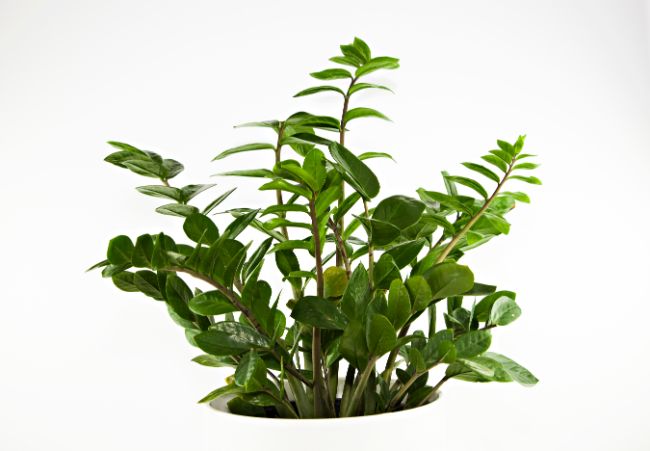
Neglect your ZZ Plant as much as you want, and it is still going to love you and thrive. No wonder then that this plant is considered an ideal choice for new gardening enthusiasts who have killed more than their fair share of houseplants in their new-found love for gardening.
Although the ZZ Plant is considered one of those slow-growing houseplants, it more than makes up for it by being so easy going and low maintenance. And it is incredibly easy to propagate too – you can even propagate it from fallen-off leaves!
Other methods of propagating this ‘survivor plant’ are by division (especially when the plant becomes pot-bound), or from stem or leaf cuttings.
String Of Pearls (Senecia Rowleyanus)
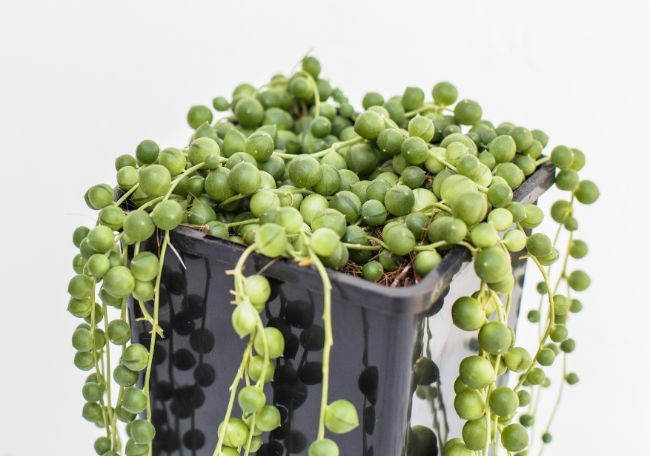
This one is a crazy pretty succulent with spherical foliage that resembles little pearls or marbles. It is usually grown in hanging pots out of which its trailing stems elegantly hang down – just like strings of pearls.
This eye-catching plant is not too fussy about moisture and humidity (it is a succulent after all), though it loves a few hours of direct sunlight every day.
String of Pearls are really easy houseplants to propagate – you just need to take stem cuttings and replant them in a well-draining container with any succulent potting soil. Make sure to keep the soil lightly moist, and the cuttings will root quickly.
Alternatively, you can place the cutting in water while ensuring the bottom part is submerged and the rest of the cutting remains hanging over the side of the jar. You will be witnessing tiny white roots in about a week or so.
Last Word
Propagating your houseplants is usually easier than most people think, and is a great way to quickly multiply your houseplant collection. It can also be a lot of fun. If you’d like to learn more about the different ways of propagating houseplants, you can read this article I wrote which covers everything you need to know.
If you’d like to grow wonderfully healthy houseplants, propagate them with ease, and deal with common care problems easily, check out my book, Houseplants Made Easy.